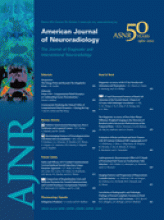Review ArticleReview Articles
Open Access
Pediatric Sensorineural Hearing Loss, Part 2: Syndromic and Acquired Causes
B.Y. Huang, C. Zdanski and M. Castillo
American Journal of Neuroradiology March 2012, 33 (3) 399-406; DOI: https://doi.org/10.3174/ajnr.A2499
B.Y. Huang
C. Zdanski

References
- 1.↵
- Billings KR,
- Kenna MA
- 2.↵
- Lalwani AK,
- Castelein CM
- 3.↵
- Morton CC,
- Nance WE
- 4.↵
- Kochhar A,
- Fischer SM,
- Kimberling WJ,
- et al
- 5.↵
- 6.↵
- 7.↵
- Senel E,
- Gulleroglu BN,
- Senel S
- 8.↵
- Pagon RA,
- Graham JM Jr.,
- Zonana J,
- et al
- 9.↵
- Verloes A
- 10.↵
- Sanlaville D,
- Verloes A
- 11.↵
- Lemmerling M,
- Dhooge I,
- Mollet P,
- et al
- 12.↵
- Morgan D,
- Bailey M,
- Phelps P,
- et al
- 13.↵
- Morimoto AK,
- Wiggins RH 3rd.,
- Hudgins PA,
- et al
- 14.↵
- Coyle B,
- Coffey R,
- Armour JA,
- et al
- 15.↵
- Reardon W,
- Trembath RC
- 16.↵
- 17.↵
- Phelps PD,
- Coffey RA,
- Trembath RC,
- et al
- 18.↵
- 19.↵
- Pingault V,
- Ente D,
- Dastot-Le Moal F,
- et al
- 20.↵
- Madden C,
- Halsted MJ,
- Hopkin RJ,
- et al
- 21.↵
- Higashi K,
- Matsuki C,
- Sarashina N
- 22.↵
- Petersen MB,
- Wang Q,
- Willems PJ
- 23.↵
- 24.↵
- 25.↵
- Kumar G,
- Castillo M,
- Buchman CA
- 26.↵
- Talbot JM,
- Wilson DF
- 27.↵
- 28.↵
- Hegarty JL,
- Patel S,
- Fischbein N,
- et al
- 29.↵
- McKenna MJ
- 30.↵
- 31.↵
- Lemmerling MM,
- De Foer B,
- Verbist BM,
- et al
- 32.↵
- Green JD Jr.,
- Marion MS,
- Hinojosa R
- 33.↵
- Jackler RK,
- Dillon WP,
- Schindler RA
- 34.↵
- Waltzman SB,
- Fisher SG,
- Niparko JK,
- et al
- 35.↵
- Marsot-Dupuch K,
- Dominguez-Brito A,
- Ghasli K,
- et al
- 36.↵
- Agrup C
- 37.↵
- Benson AG
- 38.↵
- Lee D,
- Honrado C,
- Har-El G,
- et al
- 39.↵
- Ghorayeb BY,
- Yeakley JW
- 40.↵
- 41.↵
- 42.↵
- Mark AS,
- Seltzer S,
- Harnsberger HR
- 43.↵
- 44.↵
- 45.↵
- Evans DG,
- Birch JM,
- Ramsden RT
- 46.↵
- 47.↵
- 48.↵
- Berg AL,
- Olson TJ,
- Feldstein NA
- 49.↵
- 50.↵
- 51.↵
- 52.↵
In this issue
Advertisement
B.Y. Huang, C. Zdanski, M. Castillo
Pediatric Sensorineural Hearing Loss, Part 2: Syndromic and Acquired Causes
American Journal of Neuroradiology Mar 2012, 33 (3) 399-406; DOI: 10.3174/ajnr.A2499
0 Responses
Jump to section
Related Articles
- No related articles found.
Cited By...
- Oval window perilymph fistula in child with recurrent meningitis and unilateral hearing loss
- A Case Series of X-Linked Deafness-2 with Sensorineural Hearing Loss, Stapes Fixation, and Perilymphatic Gusher: MR Imaging and Clinical Features of Hypothalamic Malformations
- The Unwound Cochlea: A Specific Imaging Marker of Branchio-Oto-Renal Syndrome
- Spectrum of Third Window Abnormalities: Semicircular Canal Dehiscence and Beyond
- Spectrum of Temporal Bone Abnormalities in Patients with Waardenburg Syndrome and SOX10 Mutations
This article has not yet been cited by articles in journals that are participating in Crossref Cited-by Linking.
More in this TOC Section
Similar Articles
Advertisement











